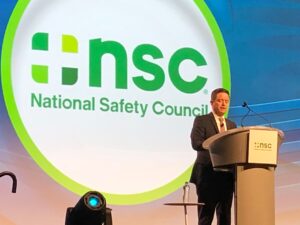The Occupational Safety and Health Administration (OSHA) is working to update its own processes as it emphasizes the need for businesses to truly embrace health and safety.
Speaking at the National Safety Council’s 2022 NSC Safety Congress & Expo in San Diego last week, OSHA’s Assistant Secretary of Labor Doug Parker noted that in 2020, 4,764 U.S. workers died from workplace-related injuries and nearly 3 million were injured.
“We can and must do better,” Parker said. “Our goal is to have businesses embrace health and safety as a core value.”
He described three types of businesses: Companies that are going far beyond just complying with safety requirements, companies that are trying to comply but struggling, and companies who treat safety compliance as a cost of doing business. Businesses in the first group typically have better morale, attract and retain more employees, and save money on lost worker hours and worker compensation claims, Parker noted.
“Safe and healthy workplaces make good business sense,” he said.
The second group he mentioned should take advantage of the resources that OSHA offers. “We want to work with businesses who are trying but not quite getting there with safety,” said Parker.
For the third category of business, Parker was blunt in his criticism. “We have to have a complete intolerance for this sort of conduct.”
A similar attitude toward these companies should also come from workers, industry peers, and businesses who work with them, said Parker.
OSHA is updating its own health and safety processes to reflect the focus on safety as a core value. This includes hiring 400 new employees since August 21, including inspectors and whistleblower investigators. The agency is also building up subject matter experts in areas such as ergonomics, Parker added.
Focus areas
Parker highlighted several areas of focus for OSHA:
- Rulemaking: Parker said OSHA is working on a permanent COVID-19 rule for healthcare, as well as an emerging infectious diseases standard. A heat stress rule is in the works. The agency is also working on modernizing “a number of our rules,” including the mechanical press standard and the powered industrial trucks standard. Another focus is personal protective equipment in construction.
- Safe + Sound: OSHA’s Safe + Sound campaign provides employers with tools to build health and safety programs. It has transitioned to a year-round program and features three components: Management leadership, worker participation, and focus on finding hazards.
- Leading indicators: OSHA is building a library of leading indicators and is asking employers to provide input. The agency is providing grants and compliance assistance.
- Suicide prevention: “We’re doing a great deal of work around suicide prevention,” Parker said. More than 45,000 Americans died by suicide in 2020 and the suicide rate among construction workers is four times higher than the general population, he added. OSHA has signed an alliance with the American Foundation for Suicide Prevention. “We have a lot more questions than answers at this point.”
- Enforcement: Parker said OSHA is focusing its enforcement efforts on the most hazardous risks, including the four main construction hazards: falls, struck-by, caught-in, and electrical hazards. An emerging hazard is trenching: “We want everyone involved in and around trenching to be mindful of the hazards.”
- Heat stress: In April, OSHA launched a National Emphasis Program on indoor and outdoor heat hazards. OSHA can proactively inspect 70 high-risk industries; it conducted 1,500 inspections from April to September, said Parker. OSHA is focusing on acclimatization, monitoring and understanding symptoms, and reducing heat injuries indoors.

